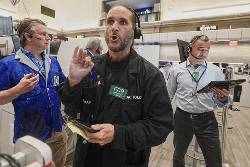Stocks moved further into record territory on Wall Street. The S&P 500 rose 0.3% Thursday, its second record in a row. The Dow Jones Industrial Average climbed 0.2%, eking out an all-time high of its own. The Nasdaq composite added 0.5%. The advances were driven largely by gains in huge tech companies including Broadcom, Alphabet and Amazon, even as many stocks fell. Spam maker Hormel sank after reporting earnings that fell short of Wall Street’s forecasts and cutting its outlook for the year. Treasury yields were little changed in the bond market following some mixed reports on the economy.
THIS IS A BREAKING NEWS UPDATE. AP’s earlier story follows below.
Stocks on Wall Street moved further into record territory in afternoon trading Thursday, following new economic data and a mixed batch of earnings reports from big U.S. companies.
The S&P 500 was up 0.3% and on pace for its second record high in a row. The Dow Jones Industrial Average reversed an early slide to add 67 points, or 0.2%, as of 3:30 p.m. Eastern time. The Nasdaq composite was 0.6% higher.
About 58% of the companies in the benchmark S&P 500 were in the red, but gains in big technology and communication services companies offset losses elsewhere in the market. Broadcom rose 3.1%, Oracle was 1.9% higher and Google parent Alphabet rose 2.1%.
“We’re seeing a continuation of a theme that has been in place really all year long, and that is communication services, information technology, really the areas that are surrounding this incredible capital expenditure cycle, have been the primary beneficiaries," said Bill Northey, senior investment director at U.S. Bank Asset Management.
Tech giant Nvidia was down 0.8% a day after reporting quarterly earnings and revenue that beat Wall Street analysts’ forecasts, though the company noted that sales of its artificial intelligence chipsets rose at a slower pace than analysts anticipated.
Investors consider Nvidia a barometer for the strength of the boom in artificial intelligence because the company makes most of the chips that power the technology. Its heavy weighting also gives Nvidia outsized influence as a bellwether for the broader market.
Shares in several retailers were down following their latest quarterly results.
Best Buy fell 3.9% after the consumer electronics chain's second-quarter snapshot was overshadowed by an outlook clouded due to the tariffs the U.S. is imposing on trading partners.
Despite also posting better-than-expected quarterly results, Urban Outfitters slid 8.8% after the retailer warned that it expects tariffs will increase pressure on its gross margins in the second half of the year.
Dick’s Sporting Goods fell 4.3% despite reporting second-quarter results that beat analysts' expectations.
Victoria’s Secret & Co. gave up an early gain and was down 0.1%
Burlington Stores bucked the trend. The retail chain climbed 5.8% after its latest earnings topped analysts’ estimates.
Elsewhere in the market, Spam maker Hormel sank 12.7% for one of the biggest declines among S&P 500 companies after its earnings fell short of Wall Street’s forecasts and the company cut its outlook for the year.
Traders also had their eye on new government reports on the job market and economy.
The Labor Department reported that applications for unemployment benefits fell last week, the latest sign that employers are holding onto their workers even as the economy has slowed.
The most recent government data suggests hiring has slowed sharply since this spring.
Meanwhile, the Commerce Department reported that U.S. gross domestic product —- the nation’s output of goods and services — grew at a 3.3% annual pace in the April-June quarter after shrinking 0.5% in the first three months of this year due to the fallout from the Trump administration’s trade wars.
“The GDP print reinforces the fact that this continues to be an economy, domestically, that is continuing to show a great deal of resilience in terms of producing economic growth,” Northey said.
Still, the sluggishness in the job market is a key reason that Federal Reserve Chair Jerome Powell signaled last week that the central bank may cut its key interest rate at its meeting next month.
Lower rates can boost investment prices and the economy by making it cheaper for U.S. households and businesses to borrow, but they risk worsening inflation.
Traders are still betting the Fed will trim its benchmark interest rate at its next meeting in September. Traders see an 85.3% chance that the central bank will cut the rate by a quarter of a percentage point, according to data from CME Group.
Friday will bring another update on inflation: the U.S. personal consumption expenditures index. Economists expect it to show that inflation remained at about 2.6% in July, compared with a year ago. Businesses have been warning investors and consumers about higher costs and prices because of tariffs.
Treasury yields were mixed in the bond market. The yield on the 10-year Treasury slipped to 4.21% from 4.24% late Wednesday. The two-year Treasury yield, which more closely tracks expectations for Federal Reserve action, rose to 3.64% from 3.62%.
European and Asian markets were mixed.
...


 Copyright © 1996 - 2025 CoreComm Internet Services, Inc. All Rights Reserved. | View our
Copyright © 1996 - 2025 CoreComm Internet Services, Inc. All Rights Reserved. | View our